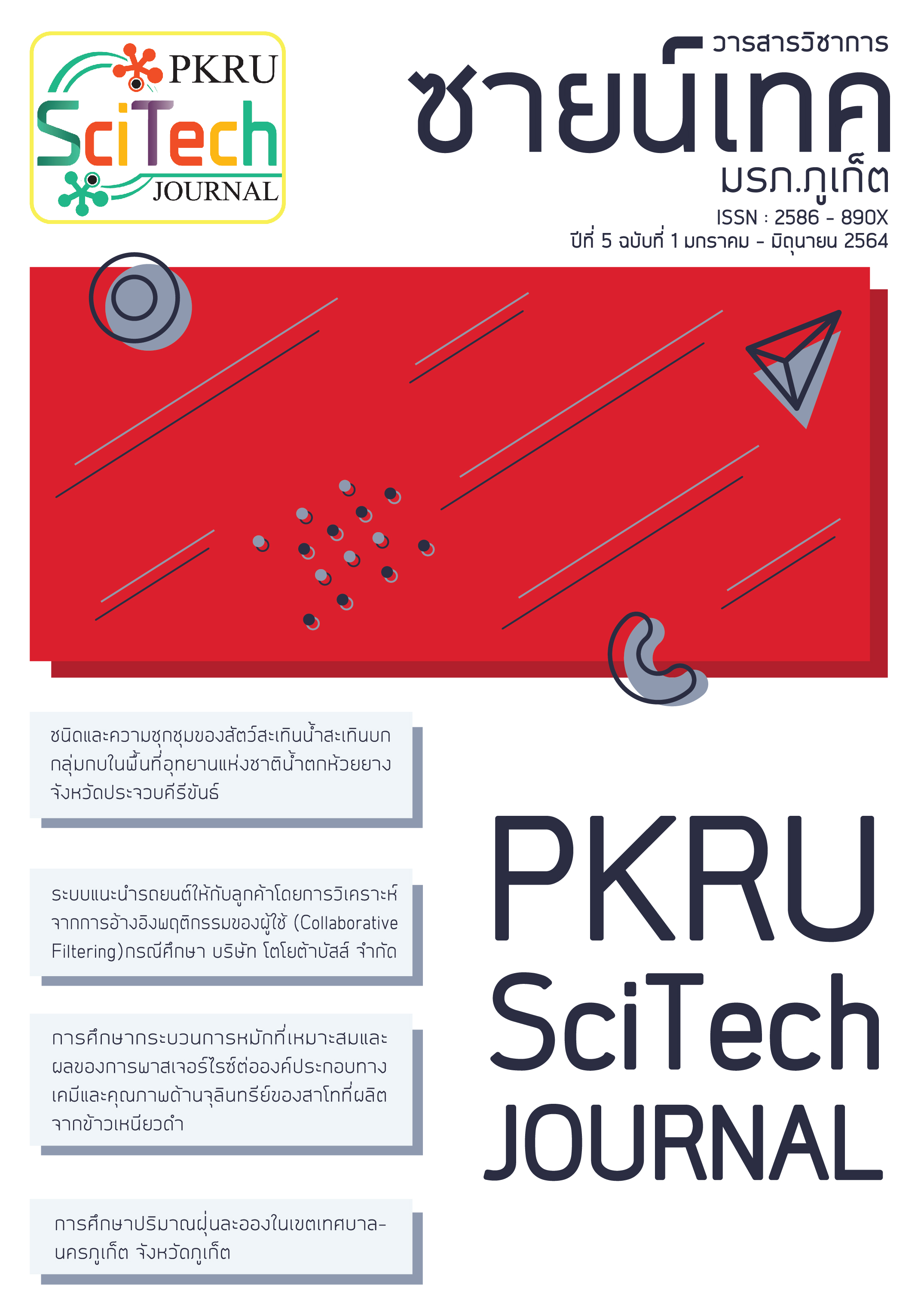การศึกษากระบวนการหมักที่เหมาะสมและผลของการพาสเจอร์ไรซ์ต่อองค์ประกอบทางเคมีและคุณภาพด้านจุลินทรีย์ของสาโทที่ผลิตจากข้าวเหนียวดำ
Main Article Content
บทคัดย่อ
สาโทข้าวเหนียวดำ (black rice wine, BRW) เป็นผลิตภัณฑ์ที่มีสีคล้ายไวน์โรเซ่เนื่องจากมีองค์ประกอบของสารแอนโธไซยานินส์เป็นองค์ประกอบหลัก การผลิตสาโทนิยมใช้โพแทสเซียมเมตาไบซัลไฟท์ เพื่อทำลายจุลินทรีย์ที่ใช้ในการผลิต แต่วิธีการดังกล่าวจะส่งผลเสียต่อผู้บริโภคที่แพ้กำมะถัน ดังนั้น งานวิจัยเรื่องนี้จึงนำการพาสเจอร์ไรซ์มาใช้ในการผลิตสาโทข้าวเหนียวดำ และศึกษาการเปลี่ยนแปลงขององค์ประกอบทางเคมีและคุณภาพด้านจุลินทรีย์ที่อาจจะเกิดขึ้นเนื่องจากกระบวนการดังกล่าว การผลิต BRW ในงานวิจัยครั้งนี้เริ่มด้วยการเปลี่ยนแป้งให้เป็นน้ำตาล (saccharification) ด้วย Aspergillus oryzae ATCC 22787 ที่ 30°C นาน 2 วัน จากนั้นหมักด้วย Saccharomyces cerevisiae NCYC 478 ที่ 25°C นาน 6 วัน และพาสเจอร์ไรซ์ที่ 70°C นาน 15 นาที จากการวิเคราะห์องค์ประกอบทางเคมีของ BRW พบว่ากรดอินทรีย์ที่ระเหยได้ (กรดโพรพิโอนิกและกรดอะซิติก) น้ำตาลมอลโทส และไซยานิดิน 3-กลูโคไซด์ ใน BRW ที่ผ่านการพาสเจอร์ไรซ์มีค่าลดลงเมื่อเปรียบเทียบกับ BRW ที่ไม่ผ่านการพาสเจอร์ไรซ์อย่างมีนัยสำคัญทางสถิติ (p<0.05) ในขณะที่ปริมาณน้ำตาลกลูโคสเพิ่มขึ้น ปริมาณแอลกอฮอล์ใน BRW ที่ผ่านการพาสเจอร์ไรซ์ไม่มีความแตกต่างกับ BRW ที่ไม่ผ่านการพาสเจอร์ไรซ์อย่างมีนัยสำคัญทางสถิติ (p≥0.05) นอกจากนี้การพาสเจอร์ไรซ์สามารถทำลายจุลินทรีย์ทั้งหมดใน BRW ได้อย่างมีประสิทธิภาพ
Article Details
- เนื้อหาต้นฉบับที่ปรากฏในวารสารเป็นความรับผิดชอบของผู้เขียน ทั้งนี้ไม่รวมความผิดพลาดอันเกิดจากเทคนิคการพิมพ์
- ลิขสิทธิ์ต้นฉบับที่ได้รับการตีพิมพ์ในวารสารวิชาการ ซายน์เทค มรภ.ภูเก็ต ถือเป็นกรรมสิทธิ์ของวารสารวิชาการ ซายน์เทค มรภ.ภูเก็ต
เอกสารอ้างอิง
Wachira, S. (2015). The production of red wine from black jasmine rice. Journal of Food Research, 4(6), 69-81.
Yotmanee, S. (2018). Identification of the characteristic taste, aroma compounds and the corresponding precursors in pigmented rice wine. PhD Thesis. UK: University of Reading.
Yodmanee, S., Karrila, T. T., & Pakdeechanuan, P. (2011). Physical, chemical and antioxidant properties of pigmented rice grown in Southern Thailand. International Food Research Journal, 18(3), 901-906.
อภิชญา เตชะวสัญญู. (2550). การแยกจำแนกและลักษณะสมบัติของยีสต์และราในลูกแป้งสุราเพื่อการผลิตสาโท. วิทยานิพนธ์ ปริญญาวิทยาศาสตรมหาบัณฑิต. กรุงเทพ: จุฬาลงกรณ์มหาวิทยาลัย.
พกนิษฐ์ พ่วงวีระกุล, และชลมารค พ่วงวีระกุล. (2547). การประกันคุณภาพสาโท. รายงานการวิจัย. กรุงเทพ: กรมโรงงานอุตสาหกรรม กระทรวงอุตสาหกรรม.
Chuchat, K., Wichai, S., & Varavut, T. (2016). Study on production of Sato from indigenous rice varieties in Nakhon Ratchasima. In The National and International Graduate Research Conference 2016. Khon Kaen University.
Wüthrich, B. (2018). Allergic and intolerance reactions to wine. Allergologie select, 2(1), 80–88.
อรอง จันทร์ประสาทสุข. (2562). การคัดแยกและจำแนกจุลินทรีย์จากลูกแป้งเป็นกล้าเชื้อสำหรับการผลิตผลิตภัณฑ์ข้าวหมัก. รายงานการวิจัย. มหาวิทยาลัยบูรพา.
Techakanon, C., & Sirimuangmoon, C. (2020). The effect of pasteurization and shelf life on the physicochemical, microbiological, antioxidant, and sensory properties of rose apple cider during cold storage. Beverages, 6(3), 1-18.
Zappa, G., Conterno, L., & Gerbi, V. 2001. Determination of organic acids, sugars, diacetyl and acetoin in cheese by high-performance liquid chromatography. Journal of agricultural and food chemistry, 49(6), 2722-2726.
Seal, T. (2016). Quantitative HPLC analysis of phenolic acids, flavonoids and ascorbic acid in four different solvent extracts of two wild edible leaves, Sonchus arvensis and Oenanthe linearis of North-Eastern region in India. Journal of Applied Phamaceutical Science, 6(2), 157-166.
ปิยมาศ แจ่มศรี, และขวัญมิตร รู้จัก. (2560). การทวนสอบอาหารเลี้ยงเชื้อชนิดแข็ง Plate count agar (PCA) และ Reasoner’s 2A (R2A) agar สำหรับการตรวจวิเคราะห์จำนวนจุลินทรีย์ทั้งหมดในน้ำและน้ำแข็ง. วารสารกรมวิทยาศาสตร์การแพทย์, 59(4), 242-251.
Capece, A., Romaniello, R., Siesto, G., & Romano, P. (2018). Conventional and non-conventional yeasts in beer production. Fermentation, 4(38), 1-11.
Park, K. M., Seo, J. A., & Kim, Y. S. (2019). Comparative study on metabolic changes of Aspergillus oryzae isolated from fermented foods according to culture conditions. International Journal of Food Microbiology, 307, 1-9.
Dalawai, N., Krupa, K. N., Nadkarni, S., Bharani, S., & Harinikumar, K. M. (2017). Screening of efficient ethanol tolerant yeast strain for production of ethanol. International journal of pure and applied bioscience, 5 (1), 744-752.
Liu, D., Zhang, H. T., Xiong, W., Hu, J., Xu, B., Lin, C. C., Xu, L., & Jiang, L. (2014). Effect of temperature on Chinese rice wine brewing with high concentration presteamed whole sticky rice. BioMed Research International, 1-8.
Kong, C. T., Ho, C. W., Ling, J. W. A., Lazim, A., Fazry, S., & Lim, S. J. (2018). Chemical changes and optimisation of acetous fermentation time and mother of vinegar concentration in the production of vinegar-like fermented papaya beverage. Sains Malaysiana, 47(9), 2017–2026.
Odriozola-Serrano, I., Soliva-Fortuny, R., & Martín-Belloso, O. (2008). Phenolic acids, flavonoids, vitamin C and antioxidant capacity of strawberry juices processed by high-intensity pulsed electric fields or heat treatments. European Food Research and Technology, 228, 239-248.


